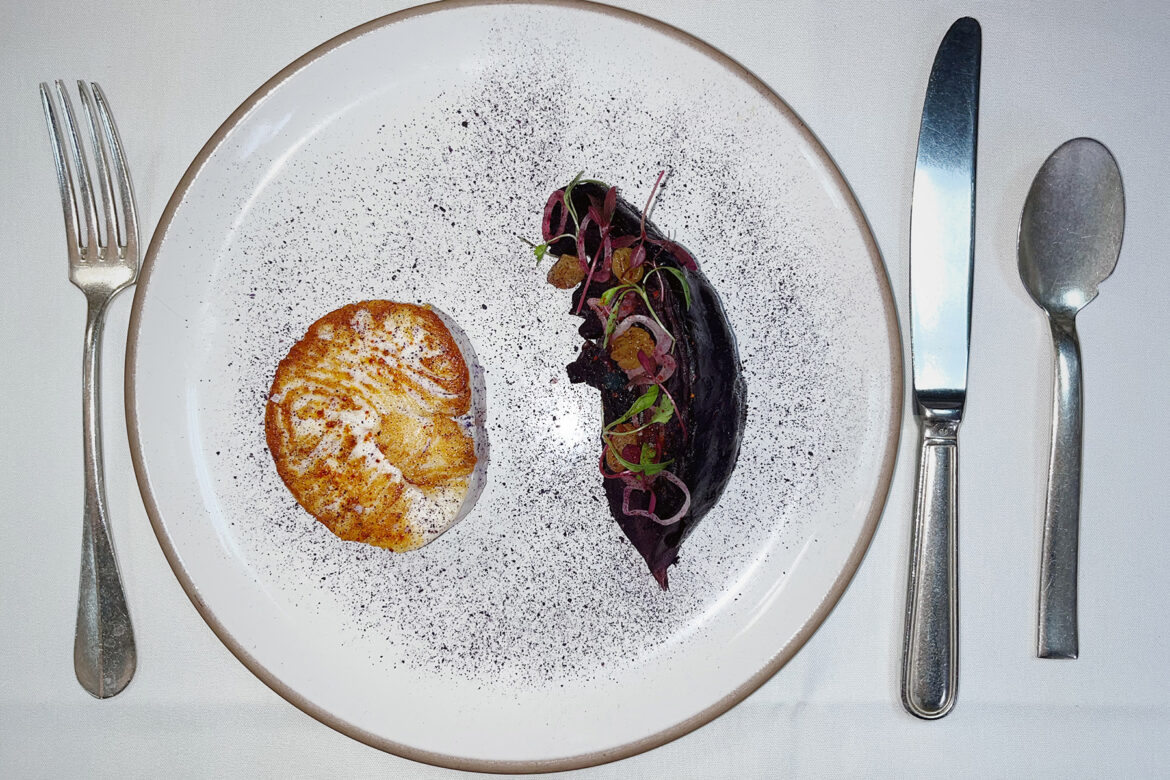The great thing about halibut is that it’s a mild tasting, yet steaky kind of fish that has the satisfying, rib-stickiness of salmon, but not at salmon’s expense. It’s also a great choice for environmentally conscious diners: the National Oceanic and Atmospheric Administration (NOAA) lists Pacific halibut as a sustainable fish. That said, this seductive recipe from Benoit by Alain Ducasse is more luxury than lesson. Here, the halibut’s characteristic mildness is offset by an intense red wine and fish stock reduction, chili-soaked raisins, shallots and sweet-yet-tart roasted cabbage hearts.
Recipe and feature photo courtesy of Benoit by Alain Ducasse. Serves 8.
Ingredients
For the Halibut
1200 g skinless halibut filet
40 g sugar
3 chilis
50 g raisins
1 purple cabbage
100 mL white wine vinegar
2 tsp fresh thyme leaves
4 cloves garlic, chopped
Salt and pepper to taste
Splash of neutral oil
1 bunch cabbage cress, for garnish
For the Sauce:
2 shallots
¼ cup apple cider vinegar
¼ cup white balsamic vinegar
200 g white onion, chopped
200 g carrots, chopped
200 g celery, chopped
2 garlic cloves
Splash olive oil
Halibut bones
1 L red wine
1 L fish stock
1 lemon, zested and juiced
Directions
Three days prior to serving the halibut, make a syrup by simmering 200 milliliters water with 40 grams of sugar. Add two chilis, chopped, and simmer for 15 minutes. Remove from heat, strain out the chilis and reserve the liquid. Add raisins and allow to macerate in refrigerator until ready to finish the dish.
One day prior to serving, prepare the cabbage. Preheat oven to 400 degrees. Remove external leaves of the cabbage. In a pot of boiling water, blanch the external leaves until wilted then place them on a rack over a rimmed pan and roast the cabbage until it’s completely crisp and dry. Cool slightly and, using a food processor, process into a fine powder. Set aside.
Meanwhile, divide the remaining head of cabbage into eight wedges. In a large bowl, combine the vinegar, thyme leaves, garlic, salt and pepper. Toss the cabbage wedges in the vinegar mixture and marinate in refrigerator overnight. Slice the shallots very thin using a mandoline. In a small bowl, combine apple cider vinegar and white balsamic vinegar and add the shallots.
Prepare the sauce. Slice the shallots very thin using a mandoline. In a small bowl, combine cider vinegar and white balsamic vinegar and add the shallots. Set aside. Preheat oven to 400 degrees. Toss together the onion, carrots, celery and garlic clove with a splash of olive oil and, in a shallow pan, roast until golden.
Meanwhile, on a pan that can go from oven to burner, roast the halibut bones until they are also golden. Remove the pan with the bones from the oven and add the roasted vegetables to the fish bones. Add the red wine and cook, scraping up any brown sticky bits. Reduce the mixture by half, then add the fish stock. Cook this for an hour, then pass the mixture through a sieve. Discard the solids. Return the liquid to the pan and continue to reduce it until the sauce is no longer watery. Set aside.
Finish the dish. Preheat the oven to 400 degrees. Remove the cabbage from the refrigerator and, in a small roasting pan, roast the cabbage in its marinade for about 45 minutes until soft. Remove from oven. Toss the halibut in a splash of neutral oil and season with salt and pepper. Roast in oven skin-side down, without turning, until it is cooked through but not dry, 20-25 minutes. Remove halibut from oven. Meanwhile, place prepared sauce over medium heat. When the sauce is hot, add lemon juice and zest to taste.
Place halibut filets on plates and garnish with cabbage cress. Place sauce to the side of the fish, add a hot cabbage wedge, garnish the plate with the marinated raisins and shallots and dust with cabbage powder. Serve.



